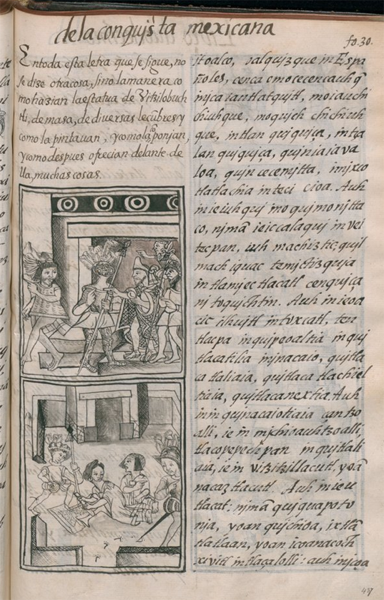Folio 30 recto
Translations and Transcriptions
Spanish Translation
[Translation of the Nahuatl into Spanish by Fr. Bernardino de Sahagún; transcription of the Spanish (left-hand column) by James Lockhart:] [f. 30r.] En todo esta letra que se sigue, no se dize otra cosa, sino la manera como hazian la estatua de Vitzilobuchtli, de masa, de diuersas lecūbres y como la pintauan, y como la cōponian, y como despues ofrecian delante della, muchas cosas.
English Translation
[Translation of the Nahuatl (right-hand column) by James Lockhart:] The Spaniards came out well adorned in battle equipment, outfitted for war, arrayed as warriors. They passed among the grinding women, circling around them, looking at each one, looking upon their faces. And when they were through looking at them, they went into the great palace. It [later] became known, according to what is said, that they would have killed people at that time if many of the men had congregated. And when the feast day of Toxcatl had arrived, toward sunset they began to give human form to [Huitzilopochtli’s] body. They formed it like a person, they made it look like a person, they gave it a person’s appearance. And what they made his body of was just dough of amaranth seed, fish amaranth seed. They placed it on a platform of sticks, “hummingbird sticks” and “ear sticks.” And when it had become like a person, then they put feather-down on his head and painted his face, making his face striped, and they [put] serpent ear plugs on him, with turquoise glued on them. And from the serpent [Translation of the Spanish (left-hand column) by James Lockhart:] In all this subsequent text, nothing else is said except the way they made the statue of Huitzilopochtli from the dough of various vegetables, how they painted it, how they arranged it, and how afterward they offered many things before it.
Analytic Transcription
[Transcription of the Nahuatl (right-hand column) by James Lockhart:] [f. 30r.] itoalco, oalquizque in Españoles, cencaomocecencauhq̄ in ica iautlatquitl, moiauchichiuhque, moquichchichiuhque, intlan quiquiça, intzalan quiquiça, quiniaiavaloa, quincecemitta, imixco tlatlachia in tecicioa. Auh in ie iuhqui in oquimonittaco, nimā ie ic calaqui in vei tecpan, iuh machiztic: quilmach iquac temictizquia intla miec tlacatl cenquiçani toquichtin. Auh in ie oacic ilhuitl in toxcatl, teutlacpa in quipeoaltia in quitlacatilia in inacaio, quitlacatlaliaia, quitlacatlachieltiaia, quitlacanextia. Auh inin quinacaiotiaia çan tzoalli, ie in michioauhtzoalli, tlacopepechpan in quitlaliaia, ie in vitzitzillacutl, yoā nacaztlacutl. Auh in ie utlacat, nimā quiquapotonia, yoan quichioa, ixtlā tlatlaan, yoan icoanacoch xivitl in tlaçalolli: auh in icoa
Image

Spanish Translation
[Translation of the Nahuatl into Spanish by Fr. Bernardino de Sahagún; transcription of the Spanish (left-hand column) by James Lockhart:] [f. 30r.] En todo esta letra que se sigue, no se dize otra cosa, sino la manera como hazian la estatua de Vitzilobuchtli, de masa, de diuersas lecūbres y como la pintauan, y como la cōponian, y como despues ofrecian delante della, muchas cosas.
English Translation
[Translation of the Nahuatl (right-hand column) by James Lockhart:] The Spaniards came out well adorned in battle equipment, outfitted for war, arrayed as warriors. They passed among the grinding women, circling around them, looking at each one, looking upon their faces. And when they were through looking at them, they went into the great palace. It [later] became known, according to what is said, that they would have killed people at that time if many of the men had congregated. And when the feast day of Toxcatl had arrived, toward sunset they began to give human form to [Huitzilopochtli’s] body. They formed it like a person, they made it look like a person, they gave it a person’s appearance. And what they made his body of was just dough of amaranth seed, fish amaranth seed. They placed it on a platform of sticks, “hummingbird sticks” and “ear sticks.” And when it had become like a person, then they put feather-down on his head and painted his face, making his face striped, and they [put] serpent ear plugs on him, with turquoise glued on them. And from the serpent [Translation of the Spanish (left-hand column) by James Lockhart:] In all this subsequent text, nothing else is said except the way they made the statue of Huitzilopochtli from the dough of various vegetables, how they painted it, how they arranged it, and how afterward they offered many things before it.
Analytic Transcription
[Transcription of the Nahuatl (right-hand column) by James Lockhart:] [f. 30r.] itoalco, oalquizque in Españoles, cencaomocecencauhq̄ in ica iautlatquitl, moiauchichiuhque, moquichchichiuhque, intlan quiquiça, intzalan quiquiça, quiniaiavaloa, quincecemitta, imixco tlatlachia in tecicioa. Auh in ie iuhqui in oquimonittaco, nimā ie ic calaqui in vei tecpan, iuh machiztic: quilmach iquac temictizquia intla miec tlacatl cenquiçani toquichtin. Auh in ie oacic ilhuitl in toxcatl, teutlacpa in quipeoaltia in quitlacatilia in inacaio, quitlacatlaliaia, quitlacatlachieltiaia, quitlacanextia. Auh inin quinacaiotiaia çan tzoalli, ie in michioauhtzoalli, tlacopepechpan in quitlaliaia, ie in vitzitzillacutl, yoā nacaztlacutl. Auh in ie utlacat, nimā quiquapotonia, yoan quichioa, ixtlā tlatlaan, yoan icoanacoch xivitl in tlaçalolli: auh in icoa
Image
